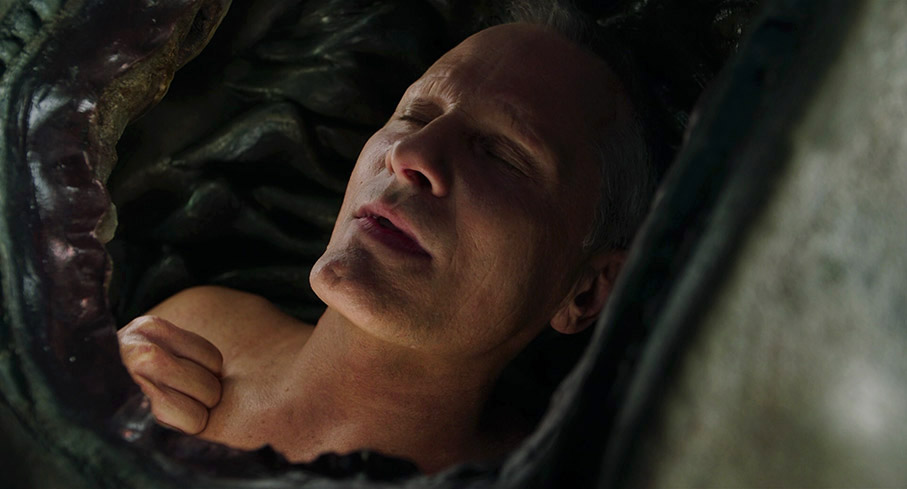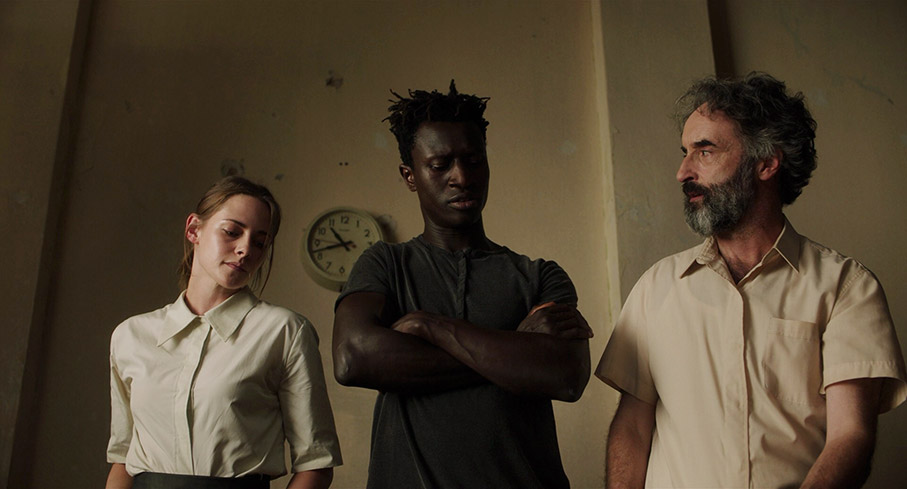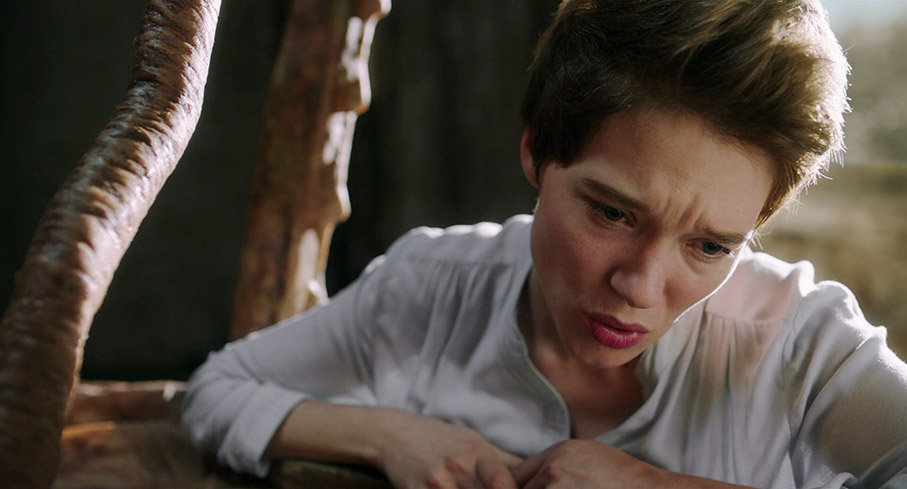| |
"I'm saying maybe that's the analogue of what an artist is. An artist is in some way offering up their essential self, inside out, to the world for some kind of nourishment that is between themselves and their audience." |
| |
David Cronenberg interviewed in Film Comment, 6 June 2022* |
"Surgery is the new sex," whispers one character to another in Crimes of the Future, David Cronenberg's first feature in eight years and one that shares a title with his second close-to feature-length film from 1970, to which it otherwise has no direct connection. It's a line that when I first heard it spoken seemed instantly destined to become an unofficial slogan for the film, much as "Long live the New Flesh," "Be afraid. Be very afraid," and "Death to the demoness, Allegra Geller" were to Videodrome, The Fly and eXistenZ respectively. As it happens, this is not the only connection to the director's earlier works you'll find lurking in the shadows here.
The film is set in an alternate reality future, one in which history seems to have taken a sideways step several years before our own current reality, resulting in some technologies developing in unexpected ways and others remaining stubbornly stagnant. Humankind has also experienced some unexplained evolutionary hiccups, wiping out infections and neutralising most people's ability to feel pain, with those who can still experience it doing so only when they sleep. While these evolutionary changes might at first glance seem to be positive ones, they also have their darker side – pain, after all, is a biological warning system, and without it the realisation that a life-threatening condition has taken hold may come too late to be acted upon. This deadening of pain receptors and immunity to infection has also given birth to what has become known as Desktop Surgery, with patients able to operate on their own bodies in non-sterile conditions without fear of infection or the need for anaesthetic. It doesn't stop there. A further bump in the evolutionary process has resulted in some individuals growing new organs at an accelerated rate, a condition that has been labelled Accelerated Evolution Syndrome. One man who has turned this to his advantage is Saul Tenser (Viggo Mortensen), a reclusive performance artist whose shows consist of him being operated on by his partner Caprice (Léa Seydoux), a former surgeon who removes the organ in question using remotely controlled biomechanical instruments, while Saul lies conscious in a specially designed organic surgical cocoon. Oh yes, this is a David Cronenberg film alright.

Before you meet Saul, however, you're going to have to process an opening scene that, while set to later become fully integrated into the narrative, also plays like an entry test for viewers unsure whether they are prepared to go to the places that Cronenberg wants to take them. A young boy named Brecken (Sotiris Sozos) sits by a seashore, digging distractedly in the sand and seemingly oblivious to the wreck of an ocean liner that lies on its side in the sea nearby, a potent symbol of a future in which so much technological progress has fallen victim to failure and decay. His mother Djuna (Lihi Kornowski) calls to him from a nearby house and tells him not to eat anything he finds, seemingly sensible advice at a point in the film when we've yet to be informed that infection is no longer a human concern. That evening, after brushing his teeth, Brecken sits down on the floor of a dingy bathroom and grasps a plastic waste basket in a way that suggests he is about to vomit into it, but a change of camera angle reveals that the noises he is making are those of consumption, as he takes bites out of the basket whilst a white liquid drools from his mouth. Djuna watches on, a troubled look on her face, and when the boy gets into bed and falls asleep, she takes a pillow and holds it over his face until he suffocates. She then makes a phone call and says to an unidentified person at other end of the line, "I want you to tell Lang that if he's interested in picking up the corpse of that creature he calls his son… Yes, yes, I mean the Brecken thing…" She then holds her head in her hands and weeps. It's worth being aware that even if you pass this test and keep watching, there are tougher ones ahead.
While the film is built around a narrative of sorts, its primary focus is the new human condition as represented by Saul and those who drift into his immediate circle. Our first introduction to him is both disorientating and disconcerting, a wide shot of what looks like a pulsing disembodied organ suspended by muscular tendrils in a darkened room. This is soon revealed to be Saul's sleep pod, one in which the organic and the electronic are combined to instinctively shift position to compensate for any pain that torments Saul during the night. When he eats, he sits in a similarly biomechanical chair that constantly shifts position and frankly looks about as comfortable as a seat made from hardwood and animal bones, which its appearance suggests that it possibly is. When darkness falls, Caprice leads him to the local National Organ Registry office to register a new organ that he has become aware is growing inside of his body, a now legally required process born of international governmental concern regarding what these new growths might ultimately transform humans into. The run-down office is manned by a single registrar named Wippet (Don McKellar) and his assistant Timlin (Kristen Stewart), both of whom are initially starstruck to be visited by a celebrity of Saul Tenser's calibre.
Seemingly more out of politeness than anything approaching friendliness, the reserved Saul invites Wippet and Timlin to his next show, where the operation performed on him by Caprice startles them both but ultimately proves to be a serious turn-on for Timlin, who approaches the recuperating Saul after the performance and whispers the line that opens this review. Also present at the show and seen earlier following Saul and Caprice to the Registry Office is Brekken's father Lang, who watches intensely and chews relentlessly on candy bars that are revealed to be fatal to anyone else unfortunate enough to take a bite from one. Also hovering on the story peripheral are a police detective named Cope (Welket Bungué), with whom Saul appears to have a secret arrangement, and two female repair technicians named Router (Nadia Litz) and Berst (Tanaya Beatty), who specialise in biomechanical sleep chambers and chairs and side-line as assassins who despatch their targets by drilling holes into their skulls.

The potential for metaphoric readings abounds in a work that intermittently feels like a recap of the themes and iconography with which Cronenberg effectively defined and developed the body horror subgenre. To get too specific would mean dropping unnecessary spoilers, but films directly and indirectly referenced include Shivers (1975), Videodrome (1983), The Fly (1986), Dead Ringers (1988), Naked Lunch (1991), Crash (1996), eXistenZ (1999) and Eastern Promises (2007), and they're just the ones that immediately jumped out at me. The connection to eXistenZ is most keenly felt in the design and the look of the technology around which Saul's life and performances revolve. These range from the skeletal 'Breakfaster' chair that constantly adjusts its position to aid the process of digestion, to the cocoon in which Saul lies when being operated on by Caprice for a captivated audience, the control pad of which has a similarly organic feel to the game pods in the earlier film.
Outside of his performances, in which he is effectively a passive participant, Saul is a withdrawn and soft-spoken isolationist, hiding his celebrity status under a black hood and cowl, which together with his black robe makes him look like a Bergmanesque vision of Death. He prefers not to interact with others and only seems to converse with anyone apart from Caprice when pushed to do so by circumstance, only seeking out Djuna of his own volition after being approached by Lang with a dark proposal that he becomes intrigued by, unaware that Lang is part of an underground group that is planning some kind of revolutionary action. It's one of several story threads that are ultimately left unresolved by an ending that is likely to leave a sizeable portion of the audience a little bewildered and wondering if the real final scene of the film has been cut from the version they are watching. Like the abrupt ending of No Country for Old Men, that view is likely to change with subsequent viewings.
While it might seem easy to write Crimes of the Future off as a darkly toned compendium of the director's greatest hits, there's clearly more going on here than a slow-burn reworking of his favourite themes and imagery. Visually, it has the steely observational detachment of Crash or Cosmopolis (or even his son Brandon Cronenberg's arresting debut, Antiviral), but the world here is noticeably darker and more corroded that the ones in which those films took place. The film's pristine digital imagery is a key factor here, the work of cinematographer Douglas Koch, who makes atmospheric use of the Arri Alexa's wide dynamic range to create areas of inky blackness and cast faces into shadow without transforming them into silhouettes.** This is a world whose interiors are bathed in an earthy toned gloom that sunlight rarely penetrates, and one that shares with Terry Gilliam's Brazil a strong sense of technological stagnation, where text is displayed on cathode ray tube televisions, information is stored on record cards and filed in wooden drawers, and Saul's performances are recorded by audience members on Super-8 and instamatic cameras. The only real technological development appears to have been in the realm of biotechnology, much of which looks almost alien in concept and design, Giger-like medical furniture and machinery that is the centrepiece of dank and decrepit rooms that otherwise contain only the most basic of fittings. It's as grimly dystopic a vision of the future – or perhaps an alternative not-so-distant past – as I've been discomforted by in a film for some years.

Several intriguing ideas are explored here, with the plastic that Brecken ingests having real-world echoes in the damage the material is now known to cause to wildlife and the microplastics that have infested the food chain. The very notion that we might one day start producing new organs of whose purpose is initially unclear is a fascinating one, given that a sure way to discover the true nature and purpose such an organ would be to allow it to grow to full maturity, by when its potential malignancy may prove fatal to its host. Thus, the fact Saul elects to build a performance around the removal of the organs that regularly grow within him allows him to capitalise on a process that would be necessary anyway. As Caprice says of the latest growth at one point, "It's not healthy. It's a breakdown of the system. An organism needs organisation. Otherwise it's just designer cancer."
As Saul, Cronenberg favourite Viggo Mortenson is even more low-key than usual, delivering most of his lines in a fatigued whisper, often whilst seated on the floor, lying down, or leaning against a wall. Ostensibly the sign of a man physically sapped by the painful growths and their unanaesthetised public removal, this was apparently enforced in part by an injury suffered by Mortensen prior to filming, when he was hit by a horse at the American Kentucky Derby.*** But he makes it part of the character of an almost pathologically unsociable man who seems to shun the light and find comfort in darkness. French actor Léa Seydoux is quietly captivating as Caprice, and Don McKellar – who was also in eXistenZ – is a ball of starstruck twitchiness as organ registrar Wippet. But the real surprise here is Kristen Stewart, who follows her fellow Twilight alumnus Robert Pattison into Cronenberg's cinema and whose clipped, almost officious delivery and melding of nervousness and suppressed fangirl admiration makes Timlin one of the most intriguing characters in the film.
There's no question that Crimes of the Future has divided audiences, being embraced by some but curtly dismissed by others, while a third group finds itself adrift between the two camps, admiring the film's craft but struggling to connect with its characters and threadbare story. On my first viewing I found myself at least sympathetic to that third camp, but just couldn't get the film out of my head and soon found myself drawn back for a second screening, and it's here that things really started to click for me. I found myself completely seduced by the film's relentlessly dark mood, its cast of quirkily fascinating characters, its fractured view of a technologically skewed future, its tactile blending of squishy practical effects and surgical CG, Howard Shore's unsettling minimalist score, and potentially enthralling story threads that are left tantalisingly dangling as potent food for thought. And as someone who has reached an age where his own body is showing its first signs of failing and who is currently recovering from surgery that has left me with a sizeable scar, I can't help thinking that this haunting, troubling but oddly intimate film was a very personal one for its 79-year-old director.
|